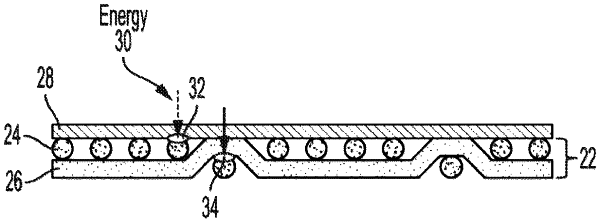| CPC D21F 7/083 (2013.01) [D21F 7/10 (2013.01)] | 38 Claims |

|
1. A structured tissue belt assembly, comprising:
a supporting layer comprising a top surface and a bottom surface, the supporting layer being formed of monofilaments comprising one or more layers of warp yarns interwoven with weft yarns in a repeating pattern,
at least one of: a) at least some of the warp yarns; orb) at least some of the weft yarns, comprising laser energy absorbent material,
at least one of: a) at least some of the warp yarns; orb) at least some of the weft yarns, comprising laser energy scattering material;
a non-woven web contacting layer comprising a bottom surface; and
one or more first laser welds that attach the bottom surface of the non-woven web contacting layer to the top surface of the supporting layer at points where the non-woven web contacting layer contacts the at least one of: a) the at least some of the warp yarns; or b) the at least some of the weft yarns that comprise laser energy absorbent material,
wherein the structured tissue belt assembly allows for air flow in x, y and z directions,
wherein an embedment distance where the web contacting layer is embedded into the monofilaments of the supporting layer is from a distance of 0.05 mm to 0.60 mm, and
wherein a peel force between the web contacting layer and the supporting layer is from 650 gf/inch to 6000 gf/inch.
|